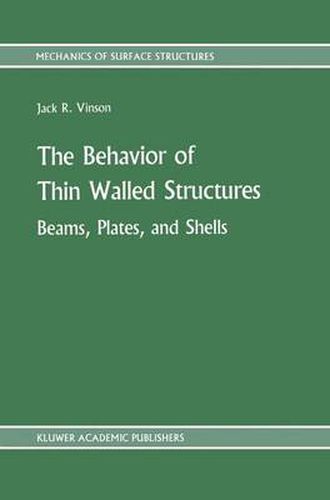Readings Newsletter
Become a Readings Member to make your shopping experience even easier.
Sign in or sign up for free!
You’re not far away from qualifying for FREE standard shipping within Australia
You’ve qualified for FREE standard shipping within Australia
The cart is loading…






This title is printed to order. This book may have been self-published. If so, we cannot guarantee the quality of the content. In the main most books will have gone through the editing process however some may not. We therefore suggest that you be aware of this before ordering this book. If in doubt check either the author or publisher’s details as we are unable to accept any returns unless they are faulty. Please contact us if you have any questions.
This book is intended primarily as a teaching text, as well as a reference for individual study in the behavior of thin walled structural components. Such structures are widely used in the engineering profession for spacecraft, missiles, aircraft, land-based vehicles, ground structures, ocean craft, underwater vessels and structures, pressure vessels, piping, chemical processing equipment, modern housing, etc. It presupposes that the reader has already completed one basic course in the mechanics or strength of materials. It can be used for both undergraduate and graduate courses. Since beams (columns, rods), plates and shells comprise components of so many of these modern structures, it is necessary for engineers to have a working knowledge of their behavior when these structures are subjected to static, dynamic (vibration and shock) and environmental loads. Since this text is intended for both teaching and self-study, it stresses fundamental behavior and techniques of solution. It is not an encyclopedia of all research or design data, but provides the reader the wherewithal to read and study the voluminous literature. Chapter 1 introduces the three-dimensional equations oflinear elasticity, deriving them to the extent necessary to treat the following material. Chapter 2 presents, in a concise way, the basic assumptions and derives the governing equations for classical Bernoulli-Euler beams and plates in a manner that is clearly understood.
$9.00 standard shipping within Australia
FREE standard shipping within Australia for orders over $100.00
Express & International shipping calculated at checkout
This title is printed to order. This book may have been self-published. If so, we cannot guarantee the quality of the content. In the main most books will have gone through the editing process however some may not. We therefore suggest that you be aware of this before ordering this book. If in doubt check either the author or publisher’s details as we are unable to accept any returns unless they are faulty. Please contact us if you have any questions.
This book is intended primarily as a teaching text, as well as a reference for individual study in the behavior of thin walled structural components. Such structures are widely used in the engineering profession for spacecraft, missiles, aircraft, land-based vehicles, ground structures, ocean craft, underwater vessels and structures, pressure vessels, piping, chemical processing equipment, modern housing, etc. It presupposes that the reader has already completed one basic course in the mechanics or strength of materials. It can be used for both undergraduate and graduate courses. Since beams (columns, rods), plates and shells comprise components of so many of these modern structures, it is necessary for engineers to have a working knowledge of their behavior when these structures are subjected to static, dynamic (vibration and shock) and environmental loads. Since this text is intended for both teaching and self-study, it stresses fundamental behavior and techniques of solution. It is not an encyclopedia of all research or design data, but provides the reader the wherewithal to read and study the voluminous literature. Chapter 1 introduces the three-dimensional equations oflinear elasticity, deriving them to the extent necessary to treat the following material. Chapter 2 presents, in a concise way, the basic assumptions and derives the governing equations for classical Bernoulli-Euler beams and plates in a manner that is clearly understood.